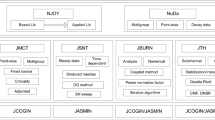Abstract
Nuclear reactor cores are constructed as rectangular or hexagonal lattices of assemblies, where each assembly is itself a lattice of fuel, control, and instrumentation pins, surrounded by water or other material that moderates neutron energy and carries away fission heat. We describe a system for generating geometry and mesh for these systems. The method takes advantage of information about repeated structures in both assembly and core lattices to simplify the overall process. The system allows targeted user intervention midway through the process, enabling modification and manipulation of models for meshing or other purposes. Starting from text files describing assemblies and core, the tool can generate geometry and mesh for these models automatically as well. Simple and complex examples of tool operation are given, with the latter demonstrating the generation of meshes with 12 million hexahedral elements in <30 min on a desktop workstation, using about 4 GB of memory. The tool is released as open source software as part of the MeshKit mesh generation library.















Similar content being viewed by others
Notes
These data were taken with CUBIT version 10.2; more recent versions of CUBIT require substantially less memory. However, because of the difficulty of porting CUBIT input scripts (journal files) between different versions of CUBIT, especially those involving many geometric operations, it was impractical to measure these data with more recent versions of CUBIT. Also, for the mesh size quoted here (<1 M elements), it is likely that the geometric model accounted for a non-negligible part of the memory usage in these data, which would not change substantially between these versions of CUBIT.
Here we assume equal spacing on the top and bottom edges bounding the surface. If biasing or some other node placement strategy is used, extra steps will typically be required to ensure the mesh matches between neighboring assemblies.
When just size is specified, the number of intervals may be changed during the “interval assignment,” which is needed to guarantee all-quadrilateral mesh ability of the bounded surface.
References
Sandia News Notes (2005) http://www.cs.sandia.gov/newsnotes/2005newsnotes.html#Goodyear
Fung S, Adler A, Chan ADC (2010) Using Dismesh as a mesh generating tool for EIT, J Phys, Conference Series
Cebral JR, Lohner R (1999) From medical images to CFD meshes. In: Proceedings of the 8th international meshing roundtable, pp 321–331
Sony BK, Shih MH (1991) TIGER: turbomachinery interactive grid GenERation. In: Proceedings of the 3rd international conference of numerical grid generation in CFD, Barcelona, Spain
Chima RV (2008) TCGRID website. http://www.grc.nasa.gov/WWW/5810/rvc/tcgrid.htm
List of Meshing Software Website. http://www-users.informatik.rwth-aachen.de/~roberts/software.html. Accessed 6 Sept 2011
PSG2/Serpent Website (2010) http://montecarlo.vtt.fi/
Riper KAV (1993) SABRINA: three-dimensional geometry visualization code system. PSR-242, ORNL-RSICC, Oak Ridge
Hansen G, Owen S (2008) Mesh generation technology for nuclear reactor simulation; barriers and opportunities. J Nucl Eng Design 238(10):2590–2605
Tautges TJ, Jain R (2010) Creating geometry and mesh models for nuclear reactor core geometries using a lattice hierarchy-based approach. In: Proceedings of the 19th international meshing roundtable. Springer, Berlin, pp 351–365
Tautges TJ, Meyers R, Merkley K, Stimpson C, Ernst C (2004) MOAB: a mesh-oriented database, SAND2004-1592. Sandia National Laboratories, Albuquerque
Tautges TJ (2005) CGM: a geometry interface for mesh generation, analysis and other applications. Eng Comput 17:486–490
Spatial Website (2010) http://www.spatial.com/
Open CASCADE Technology Website (2000–2010) http://www.opencascade.org
Ollivier-Gooch C, Diachin LF, Shephard MS, Tautges T (2007) A language-independent API for unstructured mesh access and manipulation. In: Proceedings of the 21st international symposium on high performance computing systems and applications, IEEE, p 22
Sjaardema GD, Tautges TJ, Wilson TJ, Owen SJ, Blacker TD, Bohnhoff WJ, Edwards TL, Hipp JR, Lober RR, Mitchell SA (1994) CUBIT mesh generation environment, users manual, vol 1. Sandia National Laboratories, Albuquerque
MeshKit Website (2010) http://trac.mcs.anl.gov/projects/fathom/browser/MeshKit
Smith MA, Rabiti C, Palmiotti G, Kaushik D, Siegel A, Smith B, Tautges T, Yang WS (2007) UNIC: development of a new reactor physics analysis tool. In: Proceedings of the winter meeting on international conference on making the renaissance real. American Nuclear Society, pp 565–566
Knupp PM (2001) Algebraic mesh quality metrics. SIAM J Sci Comput 23:193–218
Acknowledgments
We thank M. A. Smith, A. Wollaber, and J. H. Thomas in the Nuclear Engineering Division at Argonne National Laboratory for helpful discussions and feedback for creating the input file language used in these tools. We also thank the Fathom group at Argonne, who maintain the libraries required by this tool. This work was supported in part by the US Department of Energy Office of Nuclear Energy Nuclear Energy Advanced Modeling & Simulation (NEAMS) Program; by the US Department of Energy Office of Scientific Computing Research, Office of Science; and by the US Department of Energy’s Scientific Discovery through Advanced Computing program, under Contract DE-AC02-06CH11357.
Author information
Authors and Affiliations
Corresponding author
Additional information
The submitted manuscript has been created by UChicago Argonne, LLC, Operator of Argonne National Laboratory (“Argonne”). Argonne, a US Department of Energy Office of Science laboratory, is operated under Contract No. DE-AC02-06CH11357. The US Government retains for itself, and others acting on its behalf, a paid-up nonexclusive, irrevocable worldwide license in said article to reproduce, prepare derivative works, distribute copies to the public, and perform publicly and display publicly, by or on behalf of the Government.
Rights and permissions
About this article
Cite this article
Tautges, T.J., Jain, R. Creating geometry and mesh models for nuclear reactor core geometries using a lattice hierarchy-based approach. Engineering with Computers 28, 319–329 (2012). https://doi.org/10.1007/s00366-011-0236-8
Received:
Accepted:
Published:
Issue Date:
DOI: https://doi.org/10.1007/s00366-011-0236-8




